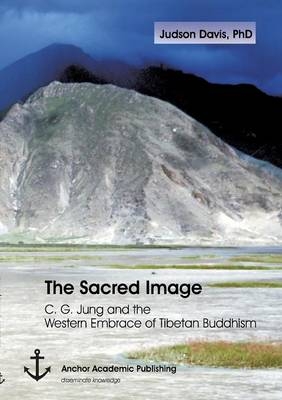
The Sacred Image: C. G. Jung and the Western Embrace of Tibetan Buddhism
Anchor Academic Publishing (Verlag)
978-3-95489-430-7 (ISBN)
modern Western psychology, and his pioneering work was greatly enhanced through his contact with Eastern religions, especially Tibetan Buddhism. In these esoteric traditions Jung discovered a holistic approach and a deep affinity for nature, and in the yogic and tantric disciplines he encountered a complex symbolic world that resonated with him deeply.
Jung was particularly drawn to the highly articulated and intricate symbolism of Tibetan Tantra, which provided considerable support for his seminal theories on the universal archetypes and the collective unconscious. His cross-cultural and interdisciplinary engagement with Indo-Tibetan spirituality later proved instrumental in establishing the basis of the modern East-West dialogue in which the religions of the East-and in particular Buddhism-have become a central focus. Jung is also widely acknowledged as the father of transpersonal psychology, which, in seeking to integrate the wisdom traditions of East and West, stands at the forefront of contemporary studies in human consciousness and mysticism.
Judson Davis, PhD, is an educator, author, spiritual counselor, documentary filmmaker, and world traveler. He holds a Doctorate in East-West Psychology from the California Institute of Integral Studies, and has taught on the college and corporate levels in California, Germany, and Japan. His work has been featured in various books and academic journals, and he presently serves on the Board of Directors of the International Association of Expressive Arts Therapists.
Text Sample:
Chapter I, Introduction:
The Western Embrace of the Tibetan Diaspora
When the iron eagle flies and horses run on wheels, the Tibetan people will be scattered over the earth and the dharma will go to the land of the red man. (Johnson, 1996, p.1)
In the more than six decades since the 1950 Chinese invasion of Tibet, there has been a profusion of Tibetan Buddhist teachings dispersed throughout the world. This process has been especially prominent in North America and Europe, where centers of tantric learning have done much to promote the proliferation of this ancient tradition. Many scholars, including the historian Arnold Toynbee (1953), have suggested that for the West the most significant incident of the last century was its direct exposure to the practices and teachings of Buddhism. And this still evolving process has been greatly expanded through the ever-increasing influence of the Tantric Buddhist tradition known as Tibetan Vajrayana. As Philip Glass wrote (as cited in Yeshe, 1987/2001):
The great Tibetan diaspora is recent history, having begun with the Chinese invasion of Tibet in the early '50s. In the decades that followed, the arrival in the West of many, many living masters of Tibetan Buddhism turned the tragedy of Tibet into an unexpected and spectacular windfall for Western devotees of spiritual discipline. (p. vii)
For more than a thousand years, the spiritual treasures of this geographically isolated and theologically secretive region had remained largely inaccessible to the outside world. However, in the early decades of the last century a few intrepid Westerners such as Alexandra David-Neal and Ernst Hoffman (later to be known as Lama Anagarika Govinda) managed to penetrate these mysteries through their travels and subsequent encounters with prominent practitioners of this unique Buddhist tradition. Lama Govinda (1969), who studied for many years under the able tutelage of the eminent teacher Tomo Geshe' Rinpoche, described-in October of 1956-the implications pertaining to the diffusion of this esoteric knowledge:
The importance of Tibetan tradition for our time and for the spiritual development of humanity lies in the fact that Tibet is the last living link that connects us with the civilizations of the distant past. The mystery-cults of Egypt, Mesopotamia, and Greece, of Incas and Mayas, have perished with the destruction of their civilizations. The old civilizations of India and China, though well-preserved in their ancient art and literature, and still glowing here and there under the ashes of modern thought, are buried and penetrated by so many strata of different cultural influences . . . Tibet, due to its natural isolation and its inaccessibility . . . has succeeded not only in preserving but in keeping alive the traditions of the most distant past, the knowledge of the hidden forces of the human soul and the highest achievements and esoteric teachings of Indian saints and sages. But in the storm of world-transforming events . . . these spiritual achievements will be lost for ever, unless they become an integral part of a higher civilization of humanity. (p.13)
One of the very first Tibetan masters to arrive in the United States was Geshe Ngawang Wangyal, who established the Lamaist Buddhist Monastery of America in in New Jersey in 1958. Other prominent native practitioners would follow, including Tarthang Tulku Rinpoche, who founded the Nyingma Institute in Berkeley, California in 1969. In the early 1970s America witnessed the arrival of a profusion of Tibetan tulkus, lamas, and rinpoches, and through the work of native practitioners such as Thubten Zopa Rinpoche, Lama Yeshe, and Chogyam Trungpa Rinpoche, the guidance of proficient tantric meditators and teachers became widely accessible. Naropa University (the first four-year Buddhist college in America) was established by Chogyam Trungpa in Boulder, Colorado in 1974, and in the years that followed organizations such as the Esalen
| Erscheinungsdatum | 21.10.2015 |
|---|---|
| Sprache | englisch |
| Maße | 155 x 220 mm |
| Gewicht | 289 g |
| Themenwelt | Geisteswissenschaften ► Psychologie |
| Sozialwissenschaften ► Soziologie ► Allgemeine Soziologie | |
| ISBN-10 | 3-95489-430-0 / 3954894300 |
| ISBN-13 | 978-3-95489-430-7 / 9783954894307 |
| Zustand | Neuware |
| Haben Sie eine Frage zum Produkt? |
aus dem Bereich


